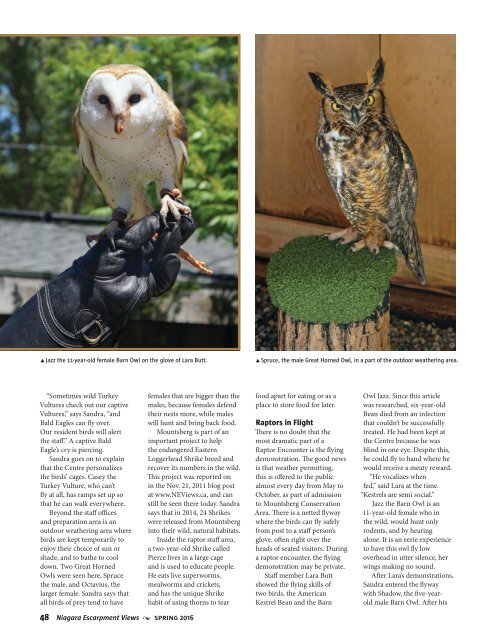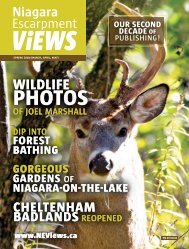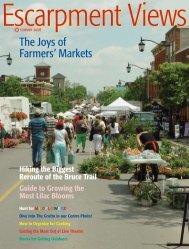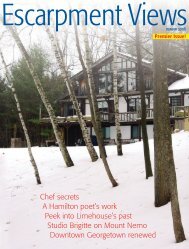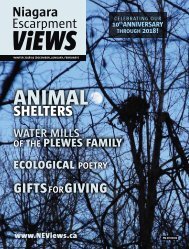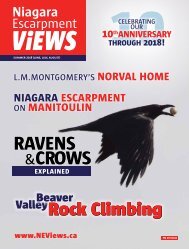Niagara Escarpment Views - Spring 2016
You also want an ePaper? Increase the reach of your titles
YUMPU automatically turns print PDFs into web optimized ePapers that Google loves.
▲ Jazz the 11-year-old female Barn Owl on the glove of Lara Butt.<br />
▲ Spruce, the male Great Horned Owl, in a part of the outdoor weathering area.<br />
“Sometimes wild Turkey<br />
Vultures check out our captive<br />
Vultures,” says Sandra, “and<br />
Bald Eagles can fly over.<br />
Our resident birds will alert<br />
the staff.” A captive Bald<br />
Eagle’s cry is piercing.<br />
Sandra goes on to explain<br />
that the Centre personalizes<br />
the birds’ cages. Casey the<br />
Turkey Vulture, who can’t<br />
fly at all, has ramps set up so<br />
that he can walk everywhere.<br />
Beyond the staff offices<br />
and preparation area is an<br />
outdoor weathering area where<br />
birds are kept temporarily to<br />
enjoy their choice of sun or<br />
shade, and to bathe to cool<br />
down. Two Great Horned<br />
Owls were seen here, Spruce<br />
the male, and Octavius, the<br />
larger female. Sandra says that<br />
all birds of prey tend to have<br />
females that are bigger than the<br />
males, because females defend<br />
their nests more, while males<br />
will hunt and bring back food.<br />
Mountsberg is part of an<br />
important project to help<br />
the endangered Eastern<br />
Loggerhead Shrike breed and<br />
recover its numbers in the wild.<br />
This project was reported on<br />
in the Nov. 21, 2011 blog post<br />
at www.NE<strong>Views</strong>.ca, and can<br />
still be seen there today. Sandra<br />
says that in 2014, 24 Shrikes<br />
were released from Mountsberg<br />
into their wild, natural habitats.<br />
Inside the raptor staff area,<br />
a two-year-old Shrike called<br />
Pierce lives in a large cage<br />
and is used to educate people.<br />
He eats live superworms,<br />
mealworms and crickets,<br />
and has the unique Shrike<br />
habit of using thorns to tear<br />
food apart for eating or as a<br />
place to store food for later.<br />
Raptors in Flight<br />
There is no doubt that the<br />
most dramatic part of a<br />
Raptor Encounter is the flying<br />
demonstration. The good news<br />
is that weather permitting,<br />
this is offered to the public<br />
almost every day from May to<br />
October, as part of admission<br />
to Mountsberg Conservation<br />
Area. There is a netted flyway<br />
where the birds can fly safely<br />
from post to a staff person’s<br />
glove, often right over the<br />
heads of seated visitors. During<br />
a raptor encounter, the flying<br />
demonstration may be private.<br />
Staff member Lara Butt<br />
showed the flying skills of<br />
two birds, the American<br />
Kestrel Bean and the Barn<br />
Owl Jazz. Since this article<br />
was researched, six-year-old<br />
Bean died from an infection<br />
that couldn’t be successfully<br />
treated. He had been kept at<br />
the Centre because he was<br />
blind in one eye. Despite this,<br />
he could fly to hand where he<br />
would receive a meaty reward.<br />
“He vocalizes when<br />
fed,” said Lara at the time.<br />
“Kestrels are semi social.”<br />
Jazz the Barn Owl is an<br />
11-year-old female who in<br />
the wild, would hunt only<br />
rodents, and by hearing<br />
alone. It is an eerie experience<br />
to have this owl fly low<br />
overhead in utter silence, her<br />
wings making no sound.<br />
After Lara’s demonstrations,<br />
Sandra entered the flyway<br />
with Shadow, the five-yearold<br />
male Barn Owl. After his<br />
48 <strong>Niagara</strong> <strong>Escarpment</strong> <strong>Views</strong> • spring <strong>2016</strong>


